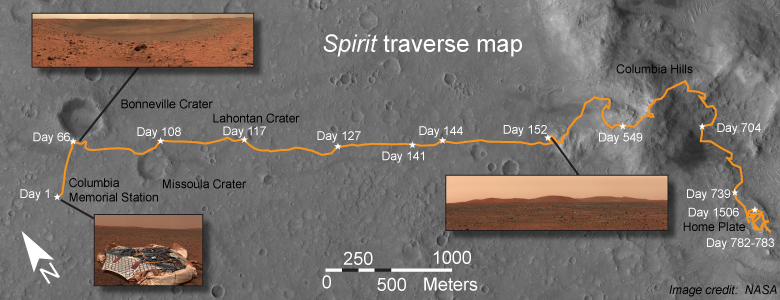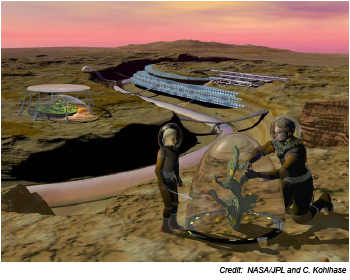|

|
Launched in mid-2003, Spirit and Opportunity were twin 180 kg rovers sent to explore opposite sides of Mars. Spirit operated for six years before going silent; its traverse map is shown above. Opportunity has lasted ten years and was still exploring at the time of publication. This is an impressive lifespan, considering that NASA had only required each rover to last for 90 days! Powered by sunlight, the rovers have both found compelling evidence that Mars once held large bodies of water—evidence such as salt deposits and layered sediments. A third, much larger rover, Curiosity, reached Mars in 2012. 
|
 There are many challenges involved in getting unmanned spacecraft to Mars. (In fact, many of the 40 missions attempted so far have ended in failure, with some crashing shortly after launch and others falling silent just as they reached their destination.) But these challenges pale beside the requirements for a successful human expedition. For starters, you would need to supply astronauts with enough air, food, and water to make the nine month journey to Mars—roughly fifty tons of supplies!—and additional supplies that will be consumed while on the red planet. Air and water can be partially recycled, but their weight is still many times more than each crew member.
There are many challenges involved in getting unmanned spacecraft to Mars. (In fact, many of the 40 missions attempted so far have ended in failure, with some crashing shortly after launch and others falling silent just as they reached their destination.) But these challenges pale beside the requirements for a successful human expedition. For starters, you would need to supply astronauts with enough air, food, and water to make the nine month journey to Mars—roughly fifty tons of supplies!—and additional supplies that will be consumed while on the red planet. Air and water can be partially recycled, but their weight is still many times more than each crew member. 
|
Once the astronauts land on Mars, you would have to protect them from constant bombardment by high-speed subatomic particles known as cosmic rays. This potentially fatal radiation is 100 times more intense on Mars than on Earth. Finally, you’ve got to bring these interplanetary pioneers home. The surface gravity on Mars is only 40% as strong as it is on Earth. It’s possible that settlers could make some of the needed rocket fuel from materials found on Mars. If not, then some of the payload brought to Mars would have to include fuel for the return flight. 
|
Why are there unmanned missions to Mars but no manned missions (so far)?
 |
Unmanned missions are safer because there isn’t a risk of people dying. Also, they are cheaper because you don’t need to do as much testing for safety, and much less mass needs to be lifted into outer space. Furthermore, unmanned missions can gather almost as much data as manned missions can. 
|
| |
|

